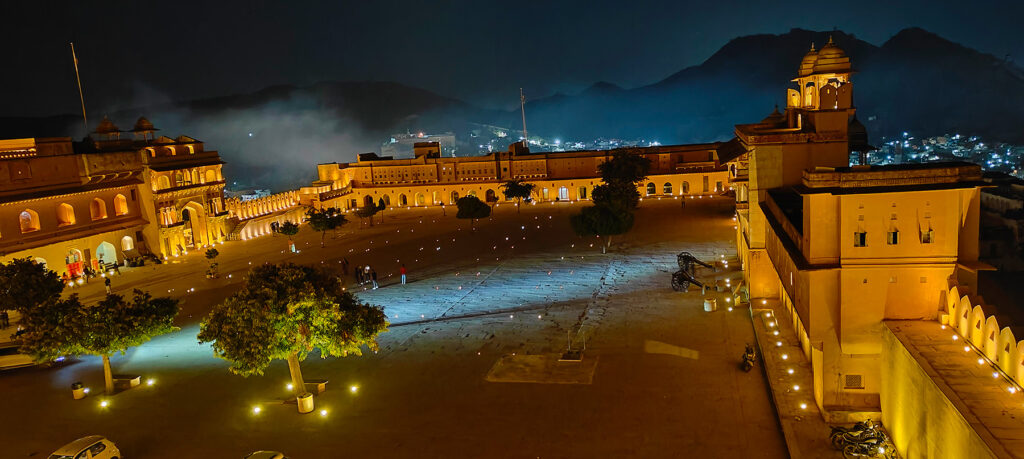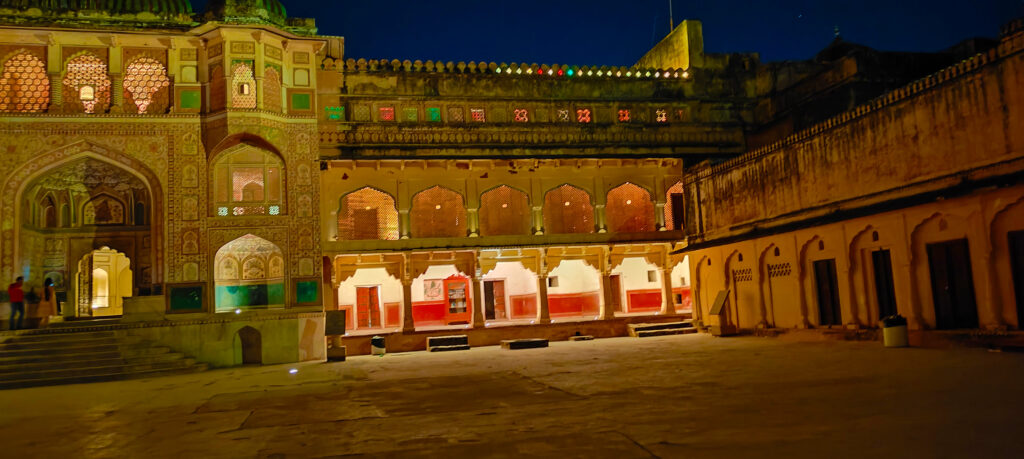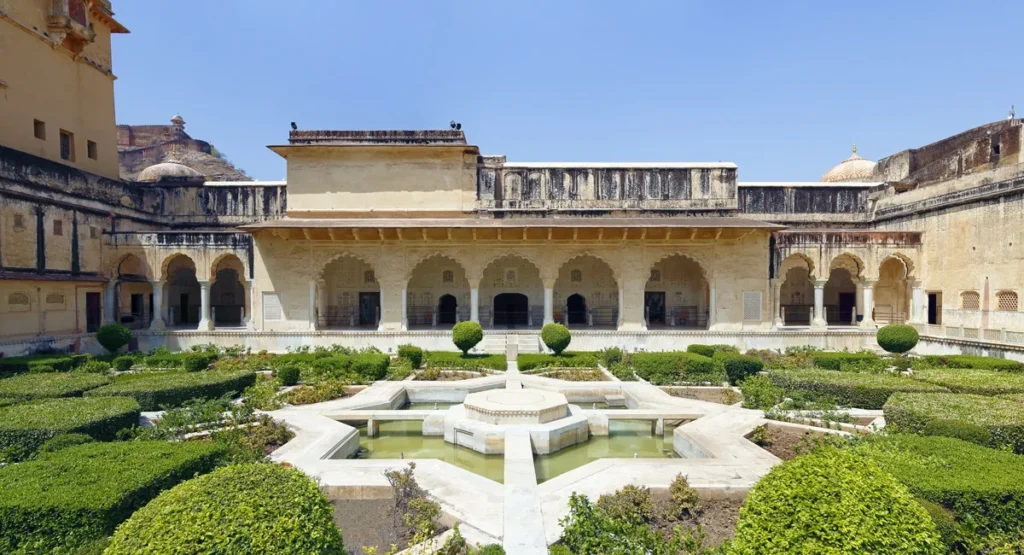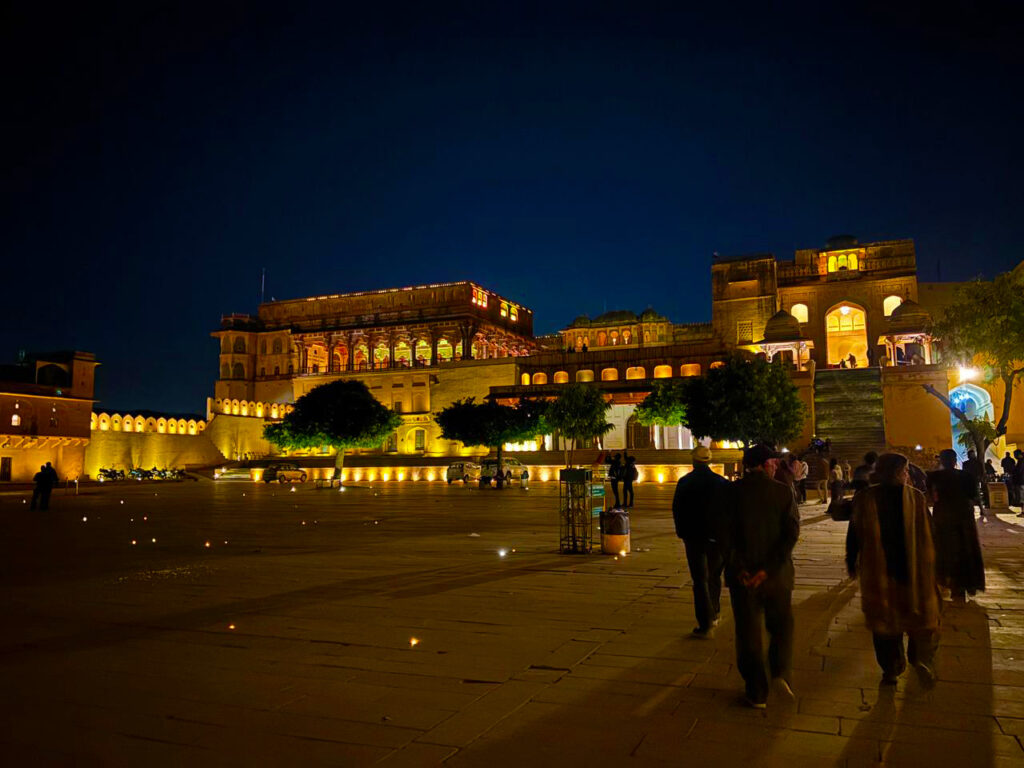Nestled in the Aravalli Hills, overlooking the serene Maota Lake, Amer Fort stands as a magnificent testament to Rajasthan’s royal grandeur. Also known as Amber Fort, this architectural marvel embodies the rich history, artistic brilliance, and strategic ingenuity of Rajputana. Every wall, courtyard, and corridor of Amer Fort whispers tales of bravery, romance, and opulence. This blog takes you on a journey through its mesmerizing past, intricate craftsmanship, and cultural significance.

A Glimpse into the History of Amer Fort
Amer was originally the stronghold of the Meena tribe before being taken over by the Kachwaha Rajputs in the 10th century. However, the grandeur of Amer Fort as we see today began with Raja Man Singh I in 1592. As one of Emperor Akbar’s trusted generals, Man Singh built the fort as a blend of Rajput and Mughal architectural styles. Over the next two centuries, successive rulers like Jai Singh I and Jai Singh II expanded and enhanced the fort, making it one of the most splendid royal residences in India.
The strategic location of Amer Fort made it an essential seat of power. For centuries, the fort played a pivotal role in safeguarding the kingdom against external threats, showcasing Rajput valor and ingenuity. Its elevated position not only provided a vantage point over approaching armies but also ensured a seamless retreat through the interconnected tunnel system leading to the Jaigarh Fort.

Architectural Brilliance of Amer Fort
Amer Fort is a breathtaking amalgamation of red sandstone and white marble, designed with a perfect balance of defensive strength and regal luxury. The fort is divided into four levels, each with its own courtyard. Here are some of its most captivating features:
Ganesh Pol – The Majestic Gateway
This grand entrance is adorned with beautiful frescoes and latticework, leading to the private palaces of the kings. Named after Lord Ganesha, the gate symbolizes good fortune and prosperity. The vibrant paintings and detailed craftsmanship make it one of the most photographed spots in the fort.

Diwan-e-Aam (Hall of Public Audience)
This expansive hall, with its stunning pillared structure, was where the king addressed public grievances and held court sessions. The delicate fusion of Mughal and Rajput styles makes it a visual delight. The intricate carvings on the pillars and arched walkways reflect the artistic genius of the craftsmen of that era.

Diwan-e-Khas (Hall of Private Audience)
A secluded hall where the ruler held confidential meetings with ministers and foreign dignitaries. The intricate floral carvings and inlaid mirror work enhance its elegance. The sophisticated design allowed for both privacy and grandeur, making it a significant venue for state affairs.

Sheesh Mahal (Mirror Palace) – A Celestial Wonder
One of the most awe-inspiring sections of Amer Fort, Sheesh Mahal is a palace covered with thousands of small mirrors. Legend has it that a single candle’s light, reflected through these mirrors, could illuminate the entire hall, creating a mesmerizing starlit effect. The grandeur of this palace is further enhanced by delicate carvings of floral patterns and geometric motifs.
Sukh Niwas (Hall of Pleasure) – A Cooling Marvel
Unlike the harsh desert heat of Rajasthan, the Sukh Niwas was designed to remain cool throughout the year. A unique water channel runs through the palace, cooling the breeze that passes over it, providing a naturally air-conditioned atmosphere. This was a revolutionary architectural technique of its time, displaying the scientific knowledge of the Rajput builders.

Shila Devi Temple – The Spiritual Heart of Amer Fort
This sacred temple, dedicated to Goddess Durga, is believed to have been a gift to Raja Man Singh after his victory in Bengal. Even today, devotees visit this temple, especially during the grand celebrations of Navratri. The black stone idol of the goddess is said to have been brought from Jessore (now in Bangladesh), symbolizing the divine blessings of the goddess on the Kachwaha dynasty.
Amer Fort’s Role in Rajput Warfare
Beyond its beauty, Amer Fort was a crucial strategic stronghold. Built atop a hill, it provided a defensive advantage against enemy invasions. The fort’s design includes hidden tunnels connecting it to Jaigarh Fort, which served as an emergency escape route during sieges. The massive walls, fortified gates, and labyrinthine passages were all engineered to withstand prolonged attacks. These tunnels were a testament to the foresight of Rajput military planners, ensuring a secure retreat if needed.

The Cultural Grandeur of Amer Fort
Amer Fort is not just an architectural marvel; it is a symbol of Rajasthan’s rich cultural heritage. It served as the royal residence of the Rajput rulers for generations, hosting grand celebrations, musical performances, and ceremonial processions.
The Enchanting Light & Sound Show
As the sun sets, Amer Fort transforms into a dazzling spectacle with a light and sound show that narrates its historical tales. The show, accompanied by soulful music and dramatic storytelling, brings the fort’s glorious past to life. The show is narrated in both English and Hindi, ensuring that visitors from all walks of life can appreciate the fort’s rich legacy.
Rajput & Mughal Fusion in Art and Design
The delicate blend of Rajputana and Mughal influences is visible in every corner of the fort. From Persian-inspired floral motifs to Rajput warrior murals, Amer Fort is a visual treat for history and art enthusiasts. The unique blend of architectural styles speaks to the cultural exchanges between the two empires.
Amer Fort and Bollywood – A Cinematic Icon
Amer Fort has served as the backdrop for many Bollywood films, including Jodha Akbar and Bajirao Mastani. Its grand courtyards, intricate balconies, and breathtaking views make it a favorite location for filmmakers and photographers alike. The fort’s dramatic architecture lends itself beautifully to period dramas and epic historical tales.
Preserving the Legacy – Amer Fort as a UNESCO World Heritage Site
Recognizing its historical and architectural importance, Amer Fort was declared a UNESCO World Heritage Site in 2013, under the Hill Forts of Rajasthan category. Conservation efforts are ongoing to maintain its splendor while accommodating millions of visitors every year. Restoration projects focus on preserving the original artwork, structures, and the delicate frescoes that adorn the fort’s walls.
How to Reach Amer Fort
- Location: 11 km from Jaipur city center
- Nearest Airport: Jaipur International Airport (13 km away)
- Nearest Railway Station: Jaipur Junction (10 km away)
- Public Transport: Local buses, taxis, and auto-rickshaws easily connect Amer Fort with Jaipur
Best Time to Visit Amer Fort
The ideal time to visit is between October and March, when the weather is pleasant, making it easier to explore the fort without the scorching summer heat. Early morning visits offer breathtaking views of the sunrise over the fort, while evenings provide a magical experience with the illuminated architecture.
Visitor Information and Tips
- Entry Fee: Rs. 112 for Indians, Rs. 550 for foreigners
- Timings: 9:30 AM – 7:30 PM daily
- Light & Sound Show: 7:30 PM (English) & 8:00 PM (Hindi)
- Guided Tours: Hiring a guide enriches the experience with fascinating historical insights
- Photography: A paradise for photographers, especially during sunrise and sunset
- Elephant Rides: Available in the mornings for a royal ascent to the fort
Conclusion
Amer Fort is more than just a tourist attraction—it’s a journey into Rajasthan’s regal past, filled with awe-inspiring architecture, valiant tales, and cultural richness. Whether you’re a history buff, an architecture enthusiast, or a traveler seeking grandeur, Amer Fort promises an unforgettable experience. As you walk through its resplendent corridors and marvel at its royal charm, you’ll realize why Amer Fort remains one of the most cherished landmarks of India.



